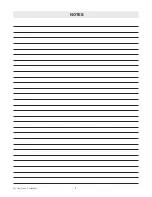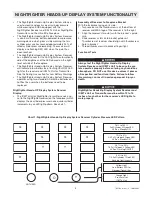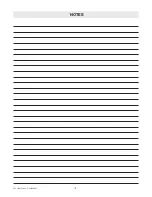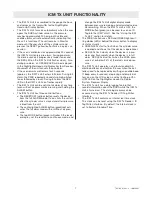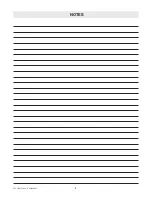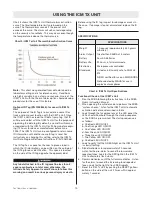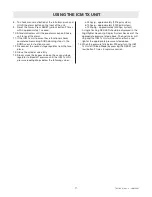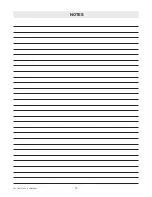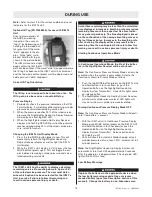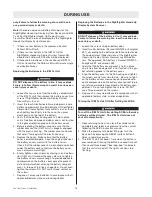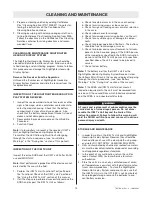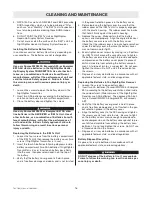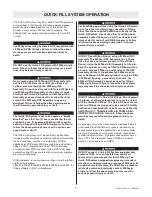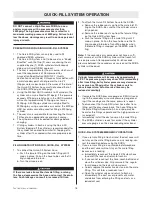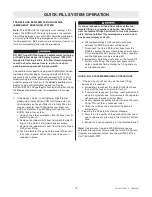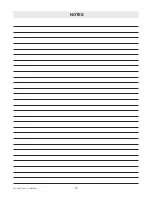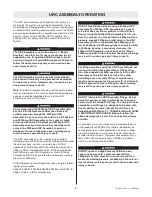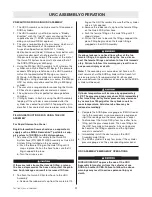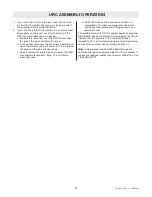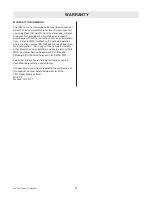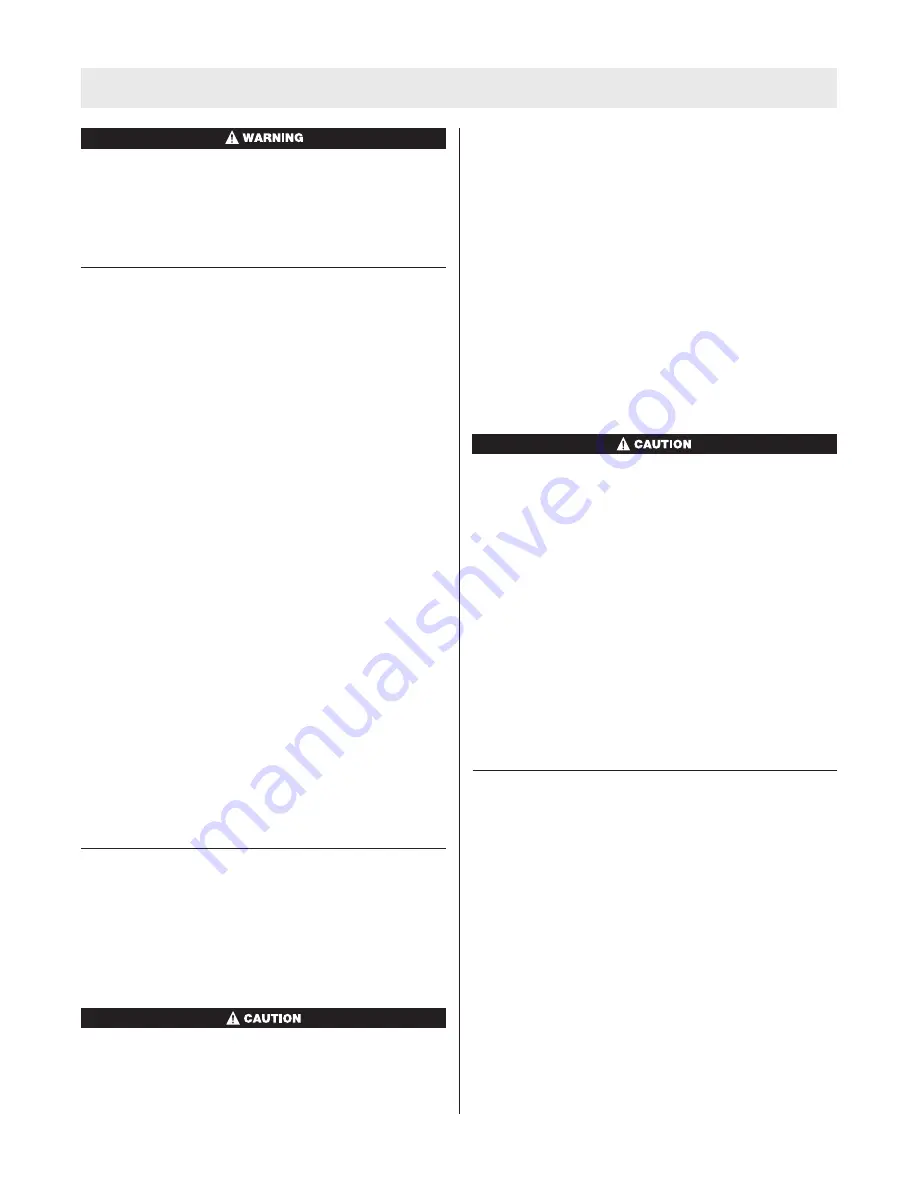
QUICK-FILL SYSTEM OPERATION
DO NOT connect a High Pressure SCBA to a sec-
ondary air source with a pressure greater than
4500psig. The high pressure air mask is rated for a
maximum working pressure of 4500psig. Failure to fol-
low the above warnings may result in serious personal
injury or death.
PRECAUTIONS FOR USING QUICK-FILL SYSTEM
1. The Quick-Fill System can only be used to fill
approved SCBA cylinders.
2. The Quick-Fill System is not to be used as a "Buddy
Breather" such that two (2) users are sharing the air
supplied by one (1) SCBA cylinder simultaneously
doing so will void NIOSH approval.
3. The user is responsible for the air source, which must
meet the requirements of Compressed Gas
Association Specification ANSI/G-7.1, Quality
Verification Level (Grade) D Gaseous Air or better, with
a moisture dew point of not greater than -65°F
(24ppm water vapor, normal). Pressures at the inlet of
the Quick-Fill System hose must not exceed that of
the SCBA (2216psig or 4500psig).
4. Using the 3000psi URC Assembly to fill cylinders, the
cylinder can only be filled to 2216psig. If the pressure
exceeds 2216psig a relief valve in the URC Assembly
will vent at approximately 2525psig or as low as
2400psig. A 3000psig cylinder can only be filled to
3000psig by using a secondary air source; the 3000psi
URC Assembly cannot be used for filling a 3000psig
cylinder.
5. The user also is responsible for connecting the Quick-
Fill hose to an appropriate secondary air source.
6. The cylinder must be inspected for damage before
charging.
7. If filling cylinders in fresh air using the Quick-Fill
System topping off the cylinder is recommended after
the cylinder has cooled from initial fill. Topping off a
cylinder after it has cooled will ensure proper service
time.
FILLING INSTRUCTIONS FOR QUICK-FILL SYSTEM
1. To connect the Quick-Fill System hose.
a. Push the female fitting on the male fitting until it
snaps in place. Pull on the hose to be sure the fit-
ting snapped into place.
b. Turn the air source on.
If there are leaks from either female fitting, or along
the hose, depressurize the hose and correct the prob-
lem. Such leakage can result in increased fill time.
2. To attach the Quick-Fill System hose to the SCBA.
c. Remove the rubber dust cap from the male inlet fit-
ting on the SCBA. Be sure that the cylinder valve is
fully opened.
d. Remove the rubber dust cap from the female fitting
on the Quick-Fill System hose.
e. Push the female fitting on the male fitting until it
snaps in place. Pull on the hose to be sure the fit-
ting snapped into place. Transfilling begins when
the female fitting is snapped on the SCBA male fit-
ting.
Note:
If the secondary air source does not have a suffi-
cient volume of air, the SCBA cylinder will not reach full
service pressure. After approximately 45-60 seconds,
pressure between the secondary air source and the SCBA
cylinder will be equal.
Cylinder temperature will increase by approximately
45°F. The pressure gauge may show FULL immediately
after transfilling, but cylinder pressure may decrease
by as much as 190psig after the cylinder cools to
room temperature. Actual service time may be
reduced accordingly.
3. Compare the SCBA pressure gauge or ICM Unit read-
ing to the secondary air source pressure gauge read-
ing. If the readings are the same, pressure is equal.
4. To disconnect the Quick-Fill System hose after trans-
filling, pull the gray sleeve back. The hose fitting and
the male fitting will separate. A hiss or pop may be
heard as the fittings separate and the high pressure air
is sealed off.
5. Immediately install the dust cover on the male fitting.
6. The SCBA cylinder is ready for service if the cylinder
pressure gauge is on the corresponding color band.
QUICK-FILL SYSTEM EMERGENCY OPERATIONS
1. If you are transfilling in fresh air and the dust cover will
not stay on the male fitting because air is leaking, cor-
rect the condition before using the SCBA.
2. If you are transfilling in a contaminated atmosphere
and the dust cover will not stay on the male fitting
because air is leaking:
a. Immediately reconnect the Quick-Fill System hose
to seal off the leak and return to fresh air.
b. If you cannot reconnect the hose, reach behind and
close the cylinder valve. Air pressure in the regula-
tor will drop and the leak will slow down.
c. Quickly replace the protective dust cap on the male
fitting. This will form a redundant seal.
d. Open the cylinder valve and return to fresh air
immediately. The dust cover prevents dirt, water
and debris from entering the fitting and acts as a
redundant seal.
18
TAL 709 (L) Rev. 4 - 10058881

